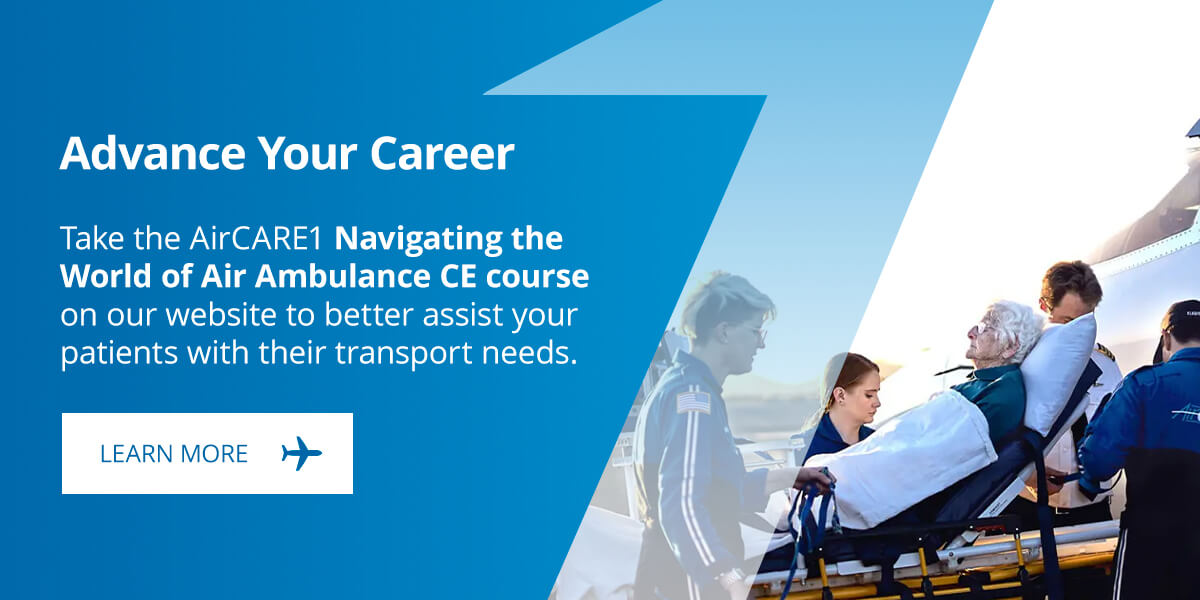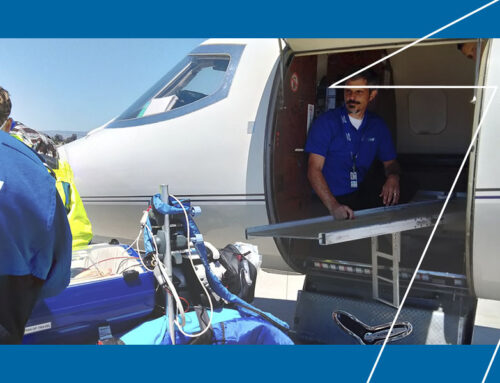The air ambulance field heavily relies on healthcare case managers to provide patients and families with essential resources and information. Without the experience and support of case managers, patients would have to navigate the air ambulance system alone. Coordinating a medical flight requires unique training to ensure patient safety and appropriate care — with AirCARE1’s “Navigating the World of Air Ambulance” (NTWOAA) course, case managers can provide the support patients need to set up an air medical transport accurately and efficiently.
AirCARE1’s Navigating the World of Air Ambulance (NTWOAA) continuing education (CE) course covers the essentials of the air ambulance industry for healthcare case managers. In this course, you can learn all you need to know about arranging patients with long-range air ambulance transports.
The Importance of Ongoing Learning in the Medical Field
The medical field is a fast-paced, constantly changing profession. Nurses, EMTs and Healthcare Case Managers must stay updated on the latest practices and procedures to ensure patient comfort and safety. With CE courses, medical professionals can stay on top of their skills, improving patient care and helping them get the treatment they need.
Both nurses and EMTs go through extensive training to ensure they can effectively care for patients. These requirements show them the ins and outs of their work. Passing these requirements gives medical professionals the foundation they need to succeed. While nurses and EMTs have basic requirements they need to meet, ongoing education is an essential part of their jobs. Nurses and EMTs have to complete CE courses throughout the year to ensure they have the most updated industry information possible.
CE Courses and Case Managers
Healthcare case managers, who are often nurses or other medical professionals, should invest in CE courses to help them perform their work effectively. Patients depend on case managers to help them through the air ambulance process. Case managers need to know the latest information so they can effectively help patients on their journey. With the right courses, case managers can continue to learn and grow while improving their patient care abilities.
Case managers can use the NTWOAA CE course as a free credit hour toward the Commission for Case Manager Certification (CCMC). The CCMC pre-approved this course to provide CCM board-certified case managers with continuing education credits.
With the NTWOAA course, case managers can learn how to make the best decisions for their patients. When they understand the type of equipment and care available on an air ambulance, they can determine when and which medical flight is the safest option for a patient.
Case managers can also learn how to choose the right air ambulance provider and navigate contracts and insurance when they take the NTWOAA course. With this knowledge, they can make medical air transport a much smoother, safer and stress-free process for patients.
How the NTWOAA CE Course Prepares Case Managers
The NTWOAA CE course prepares case managers with all the tools they need to successfully assist their patients with an air ambulance transport. Whether a patient needs to reach a specialist or travel to a hospital closer to family, the NTWOAA course gives case managers the training they need to support patients during this time. The NTWOAA CE course covers:
- Different air ambulance aircraft
- Choosing an air ambulance provider
- Asking important questions on safety, accreditations, locations and more
- Insurance
- Navigating contracts
- How transports works
- Patient transfer guidelines & paperwork
Patients might need transport for a variety of reasons — it’s the case manager’s responsibility to get them transported safely and quickly. Taking this CE course gives you all the information you need to know how to care for patients as a case manager when setting up a transport. With continuing education, you can continue to expand your skills and provide the most supportive patient care possible.
Types of Air Ambulance Aircraft
Different types of aircraft are suitable for different types of medical needs and situations. Air ambulance jets are excellent medical transports because of their safe and dependable operation and wide doors. They’re also fully equipped with specialized equipment to meet each patient’s medical needs. The NTWOAA course teaches you everything you need to know about air ambulance aircraft so you can get your patients on the right transport for their needs. You’ll learn when to use a rotorcraft or propeller aircraft for short-range transports and jets like Learjet for long-range transports.
With this CE course, you’ll stay up-to-date on the latest air ambulance aircraft and what model suits different patient needs. Understanding different aircraft helps you get your patients the right care they need while being transported.
How Air Ambulances Support Different Types of Patients
As a case manager, you must understand how to care for all patients properly so they can get the right medical services. The NTWOAA teaches about the specific type of care air ambulance teams provide and how to support a patient in any situation. With this knowledge, case managers can adjust their medical solutions to meet the following patient needs:
- Adults: Adult patients are above the age of 18, and a qualified air ambulance team should have the training, skills and equipment to also care for geriatric and bariatric individuals.
- Pediatric patients: Children and teenagers under the age of 18 require specialized care due to their unique developmental and physiological characteristics that affect their medical needs.
- Neonate patients: Neonate patients are newborns between birth and 28 days. To safely and effectively care for neonate patients during a flight, an air ambulance team requires medical personnel with specialized neonate care training and specific equipment such as a baby pod or neonate isolette.
- Specialty patients: Air ambulances can handle most patient needs, and they can even transport patients with complex medical conditions such as severe acute respiratory syndrome, a recent organ transplant or an ostomy. An experienced air ambulance team has the skills and equipment to act as a fully airborne intensive care unit (ICU) until patients reach their destination.
Medical Equipment on Air Ambulances
From infusion pumps to ventilators, an air ambulance carries the equipment and supplies necessary to monitor and care for patients in flight. The NTWOAA course covers how to find the right air ambulance for the job and how to ensure your patient gets the right care through their medical records. As case manager, you’re responsible for getting relevant patient health records to the crew, allowing them to treat the patient properly during transport.
Advance Your Career With AirCARE1’s NTWOAA Course
AirCARE1 is dedicated to helping case managers provide the highest standards of care through extensive training. Our CE courses allow you to stay on top of air ambulance care for more efficient, tailored patient experiences. You’ll help transport your patient quickly while ensuring their family members stay updated. Our NTWOAA course covers the essentials and specialized knowledge necessary for case managers to handle medical transport planning and paperwork for their patients. Take the AirCARE1 Navigating the World of Air Ambulance CE course on our website to better assist your patients with their transport needs.
Linked Sources:
- https://www.airambulanceone.com/5-common-uses-air-ambulance/
- https://www.airambulanceone.com/specialized-air-ambulance-patient-transports/
- https://www.airambulanceone.com/case-managers/
- https://www.airambulanceone.com/scope-of-care/
- https://www.ncbi.nlm.nih.gov/books/NBK482358/
- https://www.cdc.gov/sars/travel/airtransport.html
- https://www.airambulanceone.com/cecourse/



